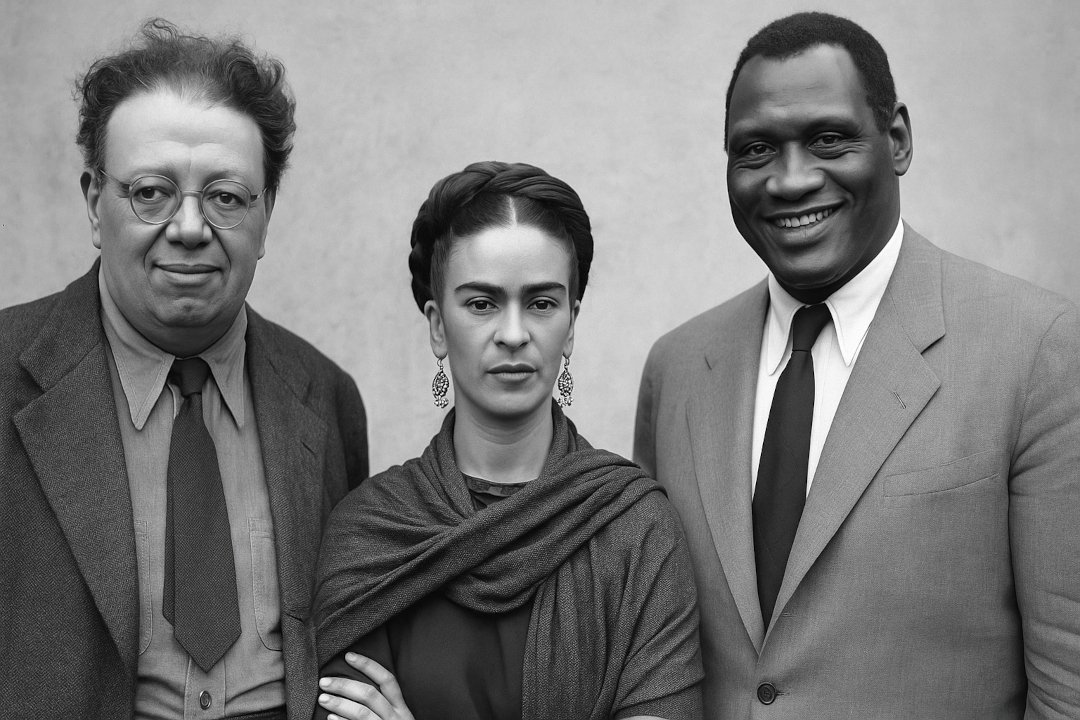Art Across Borders: How Rivera and Kahlo Connected with Black America
Frida Kahlo, Diego Rivera, and Paul Robeson pictured together in solidarity—artists and activists whose shared vision of justice transcended borders. Photo Credit: Imagined historical portrait. Generated by AI for educational and illustrative purposes.
Today, immigration policy and questions of cross-cultural solidarity continue to shape American life. In these conversations, some ask: What ties exist between the African-American and Latino communities? History offers an answer—one painted in bold strokes by Mexican artists Diego Rivera and Frida Kahlo. Though neither was Black, both forged deep alliances with African-American activists, thinkers, and artists during the 20th century. Their story reveals how art can bridge struggles for justice across borders.
🖌️ Art for the People: Rivera and the Harlem Renaissance
When Diego Rivera arrived in the U.S. in the 1930s, he brought more than his brushes—he brought a radical vision. His murals in Detroit, New York, and San Francisco celebrated workers, not kings; farmers, not gods. This resonated powerfully with African-American artists and writers of the Harlem Renaissance, who saw their own struggles reflected in Rivera’s work.
For cultural leaders like Langston Hughes, Paul Robeson, and W.E.B. Du Bois, Rivera’s murals were a revelation—his images of multiracial solidarity echoed their own fight against injustice. Rivera became a hero to the American Left, a political movement that, at the time, united activists across racial lines under shared goals: workers’ rights, racial equality, and resistance to fascism.
🤝 Frida Kahlo’s Radical Solidarity
Frida Kahlo, too, was deeply political. Though her art is often remembered for its raw intimacy and emotional intensity, she was a lifelong communist who openly criticized U.S. imperialism and capitalism. She and Rivera hosted Paul Robeson during his visits to Mexico, offering a space of welcome at a time when Jim Crow laws barred him from full participation in American life.
For many African-Americans, Mexico symbolized something rare: a place of dignity, where one’s Blackness didn’t automatically mean second-class status. Kahlo’s circle helped foster that openness. And while she did not explicitly paint Black subjects, her life and work resonated deeply with Black women artists, who identified with her fierce self-representation, her engagement with identity, and her refusal to conform.
Artists like Elizabeth Catlett, who would go on to become a Mexican citizen, and later figures such as Mickalene Thomas and Kara Walker, found in Kahlo a blueprint for how to turn personal pain into cultural power.
🎨 A Legacy Beyond Borders
Rivera and Kahlo’s influence rippled across generations of African-American artists. During the Great Depression, muralists like Charles White and John Biggers adapted Rivera’s epic scale and working-class themes to uplift Black life. Their art didn’t just decorate public spaces—it told stories that had long been silenced.
Meanwhile, Kahlo’s defiant portraits offered something just as revolutionary: an uncompromising mirror, especially for women of color navigating systems of invisibility.
What united them was a shared belief—that art should serve the people. That it should comfort, confront, and awaken. As Rivera once put it:
“To be an artist is to be a soldier in the army of justice.”
🌍 Why This History Matters Today
At first glance, Rivera and Kahlo may seem distant from African-American history. But their work reminds us that struggles for dignity are never isolated. Through murals, poems, and protest songs, the call for justice has never stopped at the border—and art has always led the way.
Today, as immigration crackdowns and racial tension continue to divide communities, some wonder what solidarity should look like now. Who has shown up for us? Who have we shown up for? These are hard, necessary questions. And while the past doesn't offer simple answers, it does offer examples—of collaboration, of mutual respect, and of artists who believed that freedom was something to be shared.
Their legacy invites us to look deeper, to ask:
What bridges might we build?
What stories have we yet to tell?

